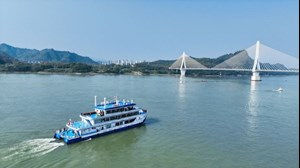News
China's first H2-powered ship makes maiden voyage to Yichang City
China's first H2 ship, the "Three Gorges H2 Boat No. 1", made its maiden voyage to Yichang City, Hubei Province. This maiden voyage represents a breakthrough in the application of H2 fuel cell technology in inland navigation vessels.
The vessel, with a steel and aluminum composite structure, has a total length of 49.9 meters, a width of 10.4 meters and a draft of 3.2 meters. Powered by a 500-kW H2 fuel cell, the ship reaches a maximum range of 200 kilometers.
After delivery, the vessel will be used for transportation, patrolling and emergency response purposes in the Three Gorges Reservoir region and between the areas between the Three Gorges and Gezhouba Dams.
The ship was jointly built by several companies, including China State Shipbuilding Corporation, China Yangtze Power Corporation and Jianglong Shipbuilding, and organizations including the Wuhan Changjiang Ship Design Institute and the Three Gorges Navigation Authority. In addition, it is the first H2 boat certified by the China Classification Society.
In recent years, the use of new electric power propulsion technology has become a key focus in the development of environmentally friendly ships. H2 energy does not generate pollution, in addition to being renewable and highly efficient. H2 fuel cells can increase the energy efficiency of ships, eliminate their emissions and improve onboard comfort, making them ideal electric propulsion devices for green ships.
Compared to traditional fuel ships, the H2 ship is expected to replace 103.16 t of fuel oil while reducing CO2 emissions by 343.67 tpy. The ship can be refueled at the Three Gorges Green Electricity and Green H2 Demonstration Station, located in Yangjia Bay in the lower reaches of the gorges.
The first H2 production and refueling station open to China's inland waters, the facility uses clean electric energy generated by the Three Gorges Power Plant to electrolyze water and produce H2 which will be directly supplied to ships H2 after compression, storage and filling. The station can supply 240 kg/hr of H2.


